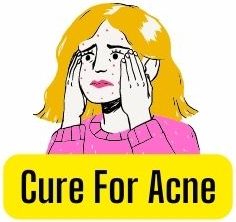Acne, a common skin condition affecting millions of individuals worldwide, is often attributed to factors such as hormonal imbalances, genetics, and poor hygiene.
However, recent scientific research has uncovered a potentially hidden culprit in the development and exacerbation of acne: dairy consumption.
This revelation may come as a surprise to many who have long been advised that chocolate or greasy foods are the primary dietary triggers for breakouts. Nevertheless, evidence-based studies have consistently demonstrated links between dairy intake and acne severity.
Understanding the relationship between dairy consumption and acne is crucial for those seeking clear skin and freedom from this often distressing condition.
This article delves into the science behind how dairy products may contribute to acne development, offers guidance on identifying personal dietary triggers, and presents various dairy alternatives that can be incorporated into one’s daily regimen for improved skin health.
Additionally, suggestions for adjusting one’s diet for preventative purposes will be discussed alongside an evaluation of effective skincare routines tailored towards combating acne caused by dairy intake.
Armed with this knowledge, individuals suffering from persistent acne can take control over their skin’s appearance by making informed choices about their diet and skincare practices.
Key Takeaways
– Dairy consumption can contribute to acne development and severity due to hormones, glycemic index, and digestive issues.
– Plant-based milk and non-dairy cheese/yogurt substitutes are viable alternatives that offer similar taste, texture, and additional nutritional benefits.
– Adjusting diet to include anti-inflammatory foods and essential nutrients can significantly contribute to acne prevention and alleviate inflammation, regulate sebum production, and maintain hormonal balance.
– Skincare adjustments and product selection are crucial elements to consider when evaluating a skincare regimen, including identifying potential triggers and incorporating anti-inflammatory components.
The Science Behind Dairy and Acne
Numerous scientific studies have unveiled the complex relationship between dairy consumption and acne, shedding light on the underlying mechanisms contributing to this prevalent skin concern.
One primary factor linking dairy to acne is its effect on hormonal imbalances within the body. Dairy products contain hormones, such as insulin-like growth factor-1 (IGF-1) and dihydrotestosterone (DHT), which can exacerbate acne by increasing sebum production and inflammation in the skin.
Furthermore, dairy’s high glycemic index may contribute to elevated insulin levels, leading to increased IGF-1 production and subsequent hormonal imbalances.
In addition to impacting hormone levels, dairy consumption has been connected to compromised gut health, further implicating it as a potential acne trigger.
The presence of lactose in dairy products may lead to digestive issues for those with lactose intolerance or sensitivity, resulting in an imbalance of gut bacteria.
This dysbiosis can cause inflammation throughout the body, manifesting itself externally as acne breakouts. Moreover, emerging research suggests that a healthy gut microbiome plays a crucial role in maintaining clear skin.
By understanding these intricate connections between dairy intake, hormonal imbalances, and gut health, individuals seeking freedom from persistent acne may be better equipped to make informed dietary choices that promote optimal skin health while addressing underlying causes holistically.
Identifying Dairy Triggers
Identifying specific dairy triggers can play a crucial role in managing acne breakouts and improving skin health. Dairy products contain various components that may contribute to the development of acne, such as hormones, growth factors, and proteins like casein and whey.
Moreover, lactose intolerance and hormonal fluctuations can also exacerbate acne symptoms in some individuals.
By pinpointing the exact dairy products that trigger breakouts, individuals can make informed decisions about their diet and take steps towards achieving clearer skin.
To effectively identify dairy triggers for acne, consider implementing the following three strategies:
- 1. Elimination Diet: Gradually remove all dairy products from your diet for a period of time (usually 4-6 weeks) to see if there is an improvement in your skin condition. After this period, slowly reintroduce one type of dairy at a time while monitoring any changes in your skin.
- 2. Food Journal: Keep a detailed record of your daily food intake along with any changes in your acne condition. This will help you track possible correlations between specific dairy products and breakouts over time.
- 3. Consultation with Professionals: Seek guidance from healthcare professionals like dermatologists or nutritionists who can provide personalized advice on identifying potential dietary triggers for acne based on individual circumstances.
By utilizing these strategies in combination with an evidence-based approach, it is possible to gain greater control over acne symptoms caused by hidden dairy culprits.
Furthermore, adopting lifestyle modifications that promote overall skin health will contribute to long-term freedom from persistent breakouts and improved well-being.
Dairy Alternatives for Clear Skin
Exploring dairy alternatives for clear skin has become increasingly popular due to the potential connection between dairy consumption and acne.
Various plant-based milk options, such as almond, soy, oat, and rice milk, have emerged as viable substitutes for individuals seeking to reduce their dairy intake.
Additionally, non-dairy cheese and yogurt substitutes made from nuts or soy have gained traction among consumers looking to maintain a well-balanced diet while avoiding potential acne triggers associated with dairy products.
Plant-based milk options
Transitioning to plant-based milk options can significantly improve skin health by eliminating the acne-triggering components found in dairy products.
These alternatives not only provide a similar taste and texture to traditional dairy milk, but also offer additional nutritional benefits.
Plant-based milks are derived from various sources such as nuts, seeds, legumes, and grains, hence offering a wide range of flavors and nutrient profiles that cater to different dietary preferences and needs. Some popular plant-based milk options include almond milk, soy milk, oat milk, and coconut milk.
Among these plant-based alternatives, several food products have emerged that serve as excellent substitutes for dairy-derived items such as ice cream and smoothies. For instance:
| Product | Base Ingredient | Benefits |
|---|---|---|
| ——— | —————– | ———- |
| Plant-Based Ice Cream | Almond Milk or Coconut Milk | Lower in Saturated Fat; Dairy-Free |
| Vegan Smoothies | Soy Milk or Oat Milk | High in Protein; Rich in Fiber |
Plant-based ice creams made with almond or coconut milk provide a creamy texture similar to traditional ice cream while being lower in saturated fat and free from acne-causing dairy components.
Vegan smoothies can be prepared using soy or oat milk which are high in protein and rich in fiber respectively – making them not only delicious but also nutritionally balanced.
By incorporating these plant-based alternatives into one’s diet regimen, individuals may experience an improvement in their skin health along with the satisfaction of embracing cruelty-free food choices – further fueling their quest for freedom from acne triggers present within conventional dairy products.
Non-dairy cheese and yogurt substitutes
Delving into the realm of non-dairy cheese and yogurt substitutes reveals a plethora of options that not only cater to lactose intolerance and vegan lifestyles but also contribute to improved skin health by eliminating acne-triggering components found in traditional dairy products.
These alternative products are crafted from various plant-based ingredients, offering not just dietary diversity but also an array of flavors and textures that can satisfy even the most discerning palate.
Soy-free options and cashew creations, in particular, stand out as popular choices for those seeking dairy-free alternatives without compromising on taste or quality. For individuals who wish to avoid soy due to allergies or personal preferences, almond-based cheeses and coconut milk yogurts provide delicious and nutritious alternatives.
Cashews serve as a versatile base for creating creamy, rich non-dairy cheeses and yogurts with a texture similar to their dairy counterparts.
Nutritional yeast is often used in vegan cheese recipes for its cheesy flavor profile while providing valuable B vitamins. Many non-dairy yogurts are fortified with live cultures, promoting gut health while still adhering to plant-based principles.
The exploration of non-dairy cheese and yogurt substitutes provides consumers with an opportunity for freedom—the freedom from animal-derived ingredients, potential allergens, or acne-inducing substances.
As the market continues to expand with innovative offerings catering to diverse dietary needs and preferences, it becomes increasingly evident that these products hold significant promise in contributing not only towards personal health benefits but also fostering greater environmental sustainability.
With this newfound knowledge at hand, one can confidently embark on a journey towards clearer skin and improved overall well-being through the incorporation of these alternative food choices into their daily lives.
Adjusting Your Diet for Acne Prevention
Incorporating anti-inflammatory foods and balancing overall nutrient intake can significantly contribute to acne prevention.
Research has demonstrated that an optimal dietary approach may help alleviate inflammation, regulate sebum production, and maintain hormonal balance, thus reducing the incidence of acne breakouts.
A comprehensive understanding of these dietary modifications is essential for individuals seeking effective strategies to attain clear skin through nutrition management.
Incorporating anti-inflammatory foods
Embracing a diet rich in anti-inflammatory foods can provide significant benefits for those seeking to alleviate acne symptoms and promote overall skin health. Inflammation reduction is crucial in managing acne breakouts, as it can help soothe the skin and prevent further aggravation of acne lesions. Incorporating soothing superfoods into one’s daily meals can contribute not only to clearer skin but also to overall wellness, as these nutrient-dense foods are known for their numerous health benefits.
To effectively incorporate anti-inflammatory foods into one’s diet, consider adding the following options:
– Leafy green vegetables: spinach, kale, collard greens
– Omega-3-rich sources: fatty fish like salmon or mackerel, walnuts, chia seeds
– Berries: blueberries, strawberries, raspberries
– Herbs and spices: turmeric, ginger, cinnamon
– Nuts and seeds: almonds, sunflower seeds
These dietary choices not only aid in inflammation reduction but also supply essential nutrients that support healthy bodily functions.
An evidence-based approach to combating acne through diet modification offers individuals a sense of freedom from reliance on solely topical treatments or medications.
By consuming a variety of powerful anti-inflammatory foods regularly, one can take control of their skincare journey while simultaneously improving overall health and well-being.
Balancing your overall nutrient intake
Achieving optimal skin health and reducing acne symptoms can be significantly influenced by maintaining a balanced overall nutrient intake, ensuring the body receives the necessary vitamins, minerals, and macro nutrients for proper functioning.
Nutrient equilibrium plays a crucial role in regulating hormone levels, immune system response, and inflammation – all factors that contribute to acne development.
Consuming a diet rich in acne-fighting foods such as fruits, vegetables, whole grains, lean proteins, and healthy fats can provide essential nutrients to support skin health while minimizing potential triggers of inflammation or hormonal imbalance.
Research suggests that certain nutrients may help reduce acne symptoms by targeting specific underlying causes.
For instance, incorporating adequate amounts of omega-3 fatty acids found in fish oil or flaxseed oil can help reduce inflammation associated with acne-prone skin.
Additionally, antioxidants like vitamin C and E protect against oxidative stress implicated in acne formation while zinc supports wound healing and immune function. These nutrients can be obtained through various food sources or dietary supplements if required.
Emphasizing on nutrient-dense foods rather than processed or high-sugar options will promote a healthier complexion while also contributing to overall well-being and freedom from persistent acne breakouts.
Evaluating Your Skincare Routine
Examining one’s skincare routine is essential in the battle against acne caused by dairy consumption, but how often do individuals truly assess the effectiveness of their chosen products? Skincare adjustments and product selection are crucial elements to consider when evaluating a skincare regimen.
Research suggests that certain ingredients found in skincare products may exacerbate acne caused by dairy intake, while others might help alleviate its symptoms.
To ensure an effective and well-rounded approach to addressing dairy-induced acne, individuals should:
- 1. Identify potentially irritating or pore-clogging ingredients: Some common culprits include synthetic fragrances, harsh detergents, and comedogenic oils.
- 2. Opt for gentle and non-comedogenic formulations: Products containing salicylic acid or benzoyl peroxide can help combat breakouts without further aggravating the skin.
- 3. Incorporate anti-inflammatory components: Ingredients such as niacinamide, green tea extract, or zinc can aid in reducing inflammation associated with acne.
- 4. Seek professional guidance: Consulting with a dermatologist or licensed esthetician can provide personalized recommendations based on individual skin type and concerns.
By scrutinizing their current skincare routines while considering these factors, individuals suffering from dairy-related acne will be better equipped to make informed decisions regarding product selection and overall skin health management.
This process allows for the identification of potential triggers and aids in creating an optimized plan tailored to address individual needs – ultimately leading to clearer skin and granting them the freedom they desire from persistent breakouts caused by dairy consumption.
Frequently Asked Questions
How long does it take for dairy consumption to affect acne-prone skin?
The duration for skin reactions to manifest from dairy consumption in acne-prone individuals varies, as the interplay of Acne triggers and individual predispositions contribute to this phenomenon.
Research indicates that an inflammatory response may occur within 24 to 48 hours; however, in some cases, it could take up to two weeks for noticeable changes in the skin condition.
It is essential for individuals with acne-prone skin to monitor their diet and be aware of potential triggers, such as dairy products, which may exacerbate their condition.
Adopting a proactive approach towards understanding the relationship between dietary choices and acne can empower these individuals to make informed decisions that promote healthier skin and a sense of freedom from persistent breakouts.
Are there any specific dairy products that are more likely to cause acne than others?
Dancing gracefully through a world of culinary delights, one encounters an assortment of dairy products that may elicit unwelcome effects on acne-prone skin.
Within the realm of these dairy products, certain contenders stand out as more likely to exacerbate the inflammatory responses that can contribute to this troublesome condition.
Research indicates that skim milk, in particular, has been associated with a higher likelihood of triggering acne when compared to its full-fat counterparts.
Additionally, foods rich in whey and casein proteins—such as protein powders and processed cheese—have been implicated in promoting inflammation and hormone imbalances related to acne development.
As individuals embark on their journey towards clearer skin, exploring dairy alternatives such as almond milk or coconut yogurt may offer a path towards liberation from the constraints imposed by problematic dairy consumption, thus allowing them to embrace newfound freedom for both their palate and complexion alike.
The lactose acne connection is a topic of interest in the scientific community, as evidence suggests that these two conditions might be related.
Lactose intolerance is characterized by an individual’s inability to properly digest lactose, a sugar found in dairy products, due to insufficient levels of the enzyme lactase.
Research has indicated that individuals with lactose intolerance may experience acne flare-ups when consuming dairy products, possibly due to an inflammatory response triggered by undigested lactose.
However, further studies are needed to establish a definitive link between the two conditions and determine if they are separate issues or interconnected.
In light of this potential association, many individuals seek dairy alternatives such as almond milk, soy milk, or coconut milk to maintain a balanced diet without exacerbating their skin condition.
These alternatives provide essential nutrients while reducing exposure to potential acne triggers found in traditional dairy sources.
Are there any studies showing the effects of dairy on adult acne versus teenage acne?
Research examining acne triggers has revealed a potential link between dairy consumption and the prevalence of acne in both adolescents and adults. Several studies have investigated this connection, with some suggesting that specific components in dairy products, such as hormones and growth factors, may contribute to the development or exacerbation of acne.
However, it is important to note that findings are not entirely consistent across all studies, indicating that further research is needed to establish a definitive relationship between dairy intake and adult versus teenage acne.
In light of these findings, individuals seeking to minimize their risk of developing acne may consider incorporating dairy alternatives into their diet, such as plant-based milk substitutes and non-dairy cheese options.
By doing so, they could potentially experience improved skin health while simultaneously satisfying their subconscious desire for freedom from potential dietary restrictions imposed by traditional dairy products.
What role do hormones found in dairy products play in the development of acne?
As the old saying goes, ‘You are what you eat,’and this adage rings true when examining the role of hormones found in dairy products and their impact on acne development.
Hormone imbalance is often a contributing factor to acne, as it can lead to an increase in sebum production and subsequent clogging of hair follicles.
Dairy products contain various hormones, including insulin-like growth factor 1 (IGF-1), which has been shown to exacerbate hormone imbalances and stimulate an inflammatory response within the body.
This inflammation can further aggravate acne-prone skin by causing hyperkeratinization and promoting bacterial growth.
By understanding the connection between dairy consumption and acne, individuals may be empowered with knowledge that could help them make informed dietary choices and potentially experience greater freedom from persistent breakouts.
Conclusion 💭
In conclusion, the link between dairy consumption and acne development has been scientifically established.
By identifying individual triggers and incorporating dairy alternatives into one’s diet, it is possible to minimize breakouts and achieve clear skin.
Additionally, a proper skincare routine tailored to an individual’s needs can further contribute to maintaining healthy skin.
Are there other factors to consider in the pursuit of clear skin? Undoubtedly, various lifestyle choices play a role in achieving acne-free skin; however, understanding the impact of dairy consumption provides a valuable starting point for those seeking clearer complexions.





